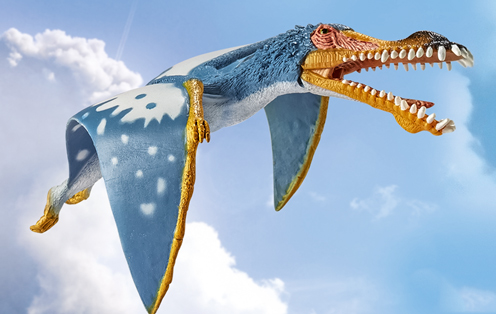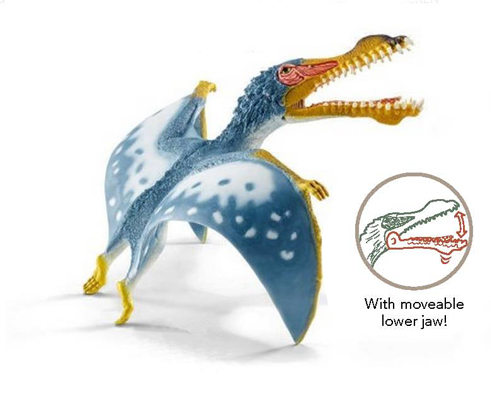Schleich Anhanguera Replica Available from Everything Dinosaur
The second of four new World of History prehistoric animal models scheduled to be introduced this year, the Schleich Anhanguera, is now in stock at Everything Dinosaur. A few years ago, Schleich added an Anhanguera replica to their smaller “dinosaurs” model range, now the German based manufacturer have added a replica of this South American pterosaur to their much larger World of History model range. Anhanguera was named and described thirty years ago (1985), and this new Schleich replica shows some marvellous details.
The Schleich Anhanguera Pterosaur Model
Picture credit: Schleich
Anhanguera
Anhanguera was a member of the Ornithocheiridae family of pterosaurs. It had a large skull, a long neck, and a relatively small body. Its vertebrae are fused together, as are its ribs and sternum, (breast-bone). This anatomy forms a kind of box-like frame, which supported large flight muscles. Modern birds have a deep keel on their sternum, an area of attachment for their flight muscles, however, pterosaurs did not possess such an anatomical feature, as a result, it had been thought that the Pterosauria would have been poor fliers.
More recent studies, undertaken over the last thirty years or so, indicate that far from being poor aeronauts the pterosaurs were strong fliers, capable of complex aerial manoeuvres. The discovery of Anhanguera fossils and other flying reptiles from the now famous Santana Formation of Brazil, has helped palaeontologists to gain a much better understanding of the aerial abilities of these vertebrates, the first group of back-boned animals to develop powered flight.
An Accomplished Aeronaut
Scientists now know that the pterosaurs, had the largest neural system for processing balance information ever seen in an animal with a spine. Flying reptiles like Anhanguera, would have been accomplished fliers, able to effortlessly skim over the waves and plunge down into the surf to snatch fish from the water, it is very likely that Anhanguera was a piscivore. The fossils of Anhanguera santanae have proved that pterosaurs had an exceptionally well developed part of their brain that managed spatial awareness (the flocculus). It is the flocculus region of the brain that interprets balance information from various parts of the body and relays this information to the eyes.
In specimens of Anhanguera that were studied, nearly 8% of the entire body mass was represented by the flocculus. In contrast, with modern Aves (birds), the flocculus organ accounts for only one to two percent of body weight.
The Schleich World of History Anhanguera
Picture credit: Schleich
Schleich Anhanguera
To view the range of Schleich prehistoric animal models currently in stock at Everything Dinosaur: Schleich World of History Models.
It is interesting to consider that as the Atlantic became wider, pterosaurs like Anhanguera would have ranged over this embryonic ocean. Palaeontologists have also noted that the large wingspans of pterosaurs such as Anhanguera santanae at over four metres would have necessitated a large flocculus as there would have been a lot of sensory information from the wings which would have had to have been interpreted by the brain. It is likely that Ornithocheiridae pterosaurs like Anhanguera were very accomplished fliers indeed.
Flying reptile expert Mark Witton, in his excellent book “Pterosaurs”, depicted a graceful Anhanguera flying over a turbulent Cretaceous sea. The pterosaur was flying over an area of the world that would eventually become southern Britain. Anhanguera and other pterosaurs like it, very probably flew in what is now United Kingdom airspace.
To read a review of “Pterosaurs” by Mark Witton: Pterosaurs – A Book Review.








Leave A Comment